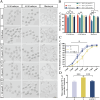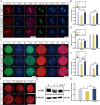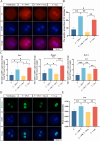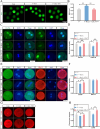The walnut-derived peptide TW-7 improves mouse parthenogenetic embryo development of vitrified MII oocytes potentially by promoting histone lactylation
- PMID: 38858724
- PMCID: PMC11165821
- DOI: 10.1186/s40104-024-01045-0
The walnut-derived peptide TW-7 improves mouse parthenogenetic embryo development of vitrified MII oocytes potentially by promoting histone lactylation
Abstract
Background: Previous studies have shown that the vitrification of metaphase II (MII) oocytes significantly represses their developmental potential. Abnormally increased oxidative stress is the probable factor; however, the underlying mechanism remains unclear. The walnut-derived peptide TW-7 was initially isolated and purified from walnut protein hydrolysate. Accumulating evidences implied that TW-7 was a powerful antioxidant, while its prospective application in oocyte cryopreservation has not been reported.
Result: Here, we found that parthenogenetic activation (PA) zygotes derived from vitrified MII oocytes showed elevated ROS level and delayed progression of pronucleus formation. Addition of 25 μmol/L TW-7 in warming, recovery, PA, and embryo culture medium could alleviate oxidative stress in PA zygotes from vitrified mouse MII oocytes, furtherly increase proteins related to histone lactylation such as LDHA, LDHB, and EP300 and finally improve histone lactylation in PA zygotes. The elevated histone lactylation facilitated the expression of minor zygotic genome activation (ZGA) genes and preimplantation embryo development.
Conclusions: Our findings revealed the mechanism of oxidative stress inducing repressed development of PA embryos from vitrified mouse MII oocytes and found a potent and easy-obtained short peptide that could significantly rescue the decreased developmental potential of vitrified oocytes, which would potentially contribute to reproductive medicine, animal protection, and breeding.
Keywords: Histone lactylation; Oocyte; TW-7; Vitrification; Zygotic genome activation.
© 2024. The Author(s).
Conflict of interest statement
The authors declare that they have no competing interests.
Figures









References
-
- Borrás A, Manau D, Fabregues F, Peralta S, Calafell JM, Casals G, et al. Comparison between slow freezing and vitrification of ovarian tissue cryopreservation in assigned female at birth transgender people receiving testosterone therapy: data on histological and viability parameters. J Assist Reprod Genet. 2022;39(2):527–541. doi: 10.1007/s10815-021-02386-9. - DOI - PMC - PubMed
-
- Barrozo LG, Paulino L, Silva BR, Barbalho EC, Nascimento DR, Neto MFL, et al. N-acetyl-cysteine and the control of oxidative stress during in vitro ovarian follicle growth, oocyte maturation, embryo development and cryopreservation. Anim Reprod Sci. 2021;231:106801. doi: 10.1016/j.anireprosci.2021.106801. - DOI - PubMed
Grants and funding
LinkOut - more resources
Full Text Sources
Miscellaneous

